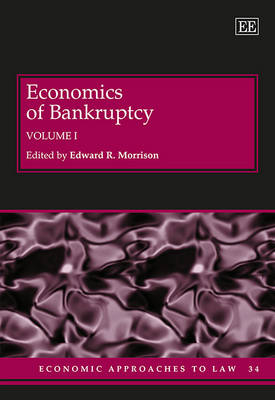
Economics of Bankruptcy
Edward Elgar Publishing Ltd (Verlag)
978-1-84542-641-5 (ISBN)
Edited by Edward R. Morrison, Charles Evans Gerber Professor of Law, Columbia Law School, US
Contents:
Volume I
Acknowledgements
Introduction Edward R. Morrison
PART ICOMPREHENSIVE THEORIES OF BANKRUPTCY LAW
1. Thomas H. Jackson (1982), ‘Bankruptcy, Non-Bankruptcy Entitlements, and the Creditors’ Bargain’
2. Douglas G. Baird and Thomas H. Jackson (1984), ‘Corporate Reorganizations and the Treatment of Diverse Ownership Interests: A Comment on Adequate Protection of Secured Creditors in Bankruptcy’
3. Douglas G. Baird (1986), ‘The Uneasy Case for Corporate Reorganizations’
4. Samuel A. Rea, Jr. (1984), ‘Arm-Breaking, Consumer Credit and Personal Bankruptcy’
5. Thomas H. Jackson (1986), ‘The Fresh-Start Policy in Bankruptcy Law’
PART IICOLLECTIVE DECISION-MAKING BEFORE BANKRUPTCY
ATheory
6. Randal C. Picker (1992), ‘Security Interests, Misbehavior, and Common Pools’
7. Patrick Bolton and David S. Scharfstein (1996), ‘Optimal Debt Structure and the Number of Creditors’
8. Arturo Bris and Ivo Welch (2005), ‘The Optimal Concentration of Creditors’
9. Barry E. Adler (1993), ‘Financial and Political Theories of American Corporate Bankruptcy’
10. Robert K. Rasmussen (1992), ‘Debtor’s Choice: A Menu Approach to Corporate Bankruptcy’
11. Alan Schwartz (1997), ‘Contracting About Bankruptcy’
12. Barry E. Adler (1997), ‘A Theory of Corporate Insolvency’
BEvidence
13. Edward R. Morrison (2009), ‘Bargaining Around Bankruptcy: Small Business Workouts and State Law’
14. Julian Franks and Oren Sussman (2005), ‘Financial Distress and Bank Restructuring of Small to Medium Size UK Companies’
15. Sergei A. Davydenko and Julian R. Franks (2008), ‘Do Bankruptcy Codes Matter? A Study of Defaults in France, Germany, and the UK’
16. Stuart C. Gilson (1997), ‘Transaction Costs and Capital Structure Choice: Evidence from Financially Distressed Firms’
PART IIIASSET DEPLOYMENT DECISIONS IN BANKRUPTCY
17. Andrei Shleifer and Robert W. Vishny (1992), ‘Liquidation Values and Debt Capacity: A Market Equilibrium Approach’
18. Todd C. Pulvino (1998), ‘Do Asset Fire Sales Exist? An Empirical Investigation of Commercial Aircraft Transactions’
19. Per Strömberg (2000), ‘Conflicts of Interest and Market Illiquidity in Bankruptcy Auctions: Theory and Tests’
20. Sugato Bhattacharyya and Rajdeep Singh (1999), ‘The Resolution of Bankruptcy by Auction: Allocating the Residual Right of Design’
21. Lucian Arye Bebchuk (1988), ‘A New Approach to Corporate Reorganizations’
22. Philippe Aghion, Oliver Hart and John Moore (1992), ‘The Economics of Bankruptcy Reform’
23. Douglas G. Baird and Robert K. Rasmussen (2002), ‘The End of Bankruptcy’
24. Douglas G. Baird and Robert K. Rasmussen (2003), ‘Chapter 11 at Twilight’
Volume II
Acknowledgements
An introduction to both volumes by the editor appears in Volume I
PART IBUSINESS BANKRUPTCY IN PRACTICE
ABankruptcy Costs
1. Arturo Bris, Ivo Welch and Ning Zhu (2006), ‘The Costs of Bankruptcy: Chapter 7 Liquidation versus Chapter 11 Reorganization’
2. Gregor Andrade and Steven N. Kaplan (1998), ‘How Costly is Financial (Not Economic) Distress? Evidence from Highly Leveraged Transactions that Became Distressed’
BFiltering Viable from Non-viable Firms
3. Lawrence A. Weiss and Karen H. Wruck (1998), ‘Information Problems, Conflicts of Interest, and Asset Stripping: Chapter 11’s Failure in the Case of Eastern Airlines’
4. Michelle J. White (1994), ‘Corporate Bankruptcy as a Filtering Device: Chapter 11 Reorganizations and Out-of-Court Debt Restructurings’
5. Matthias Kahl (2002), ‘Economic Distress, Financial Distress, and Dynamic Liquidation’
6. Vojislav Maksimovic and Gordon Phillips (1998), ‘Asset Efficiency and Reallocation Decisions of Bankrupt Firms’
7. Edward R. Morrison (2007), ‘Bankruptcy Decision Making: An Empirical Study of Continuation Bias in Small-Business Bankruptcies’
CEx Ante Investment Incentives Generally: Theory and Evidence
8. Robert Gertner and David Scharfstein (1991), ‘A Theory of Workouts and the Effects of Reorganization Law’
9. Wei Fan and Michelle J. White (2003), ‘Personal Bankruptcy and the Level of Entrepreneurial Activity’
10. Jeremy Berkowitz and Michelle J. White (2004), ‘Bankruptcy and Small Firms’ Access to Credit’
11. Douglas G. Baird and Edward R. Morrison (2005), ‘Serial Entrepreneurs and Small Business Bankruptcies’
DEx Ante Effects of Particular Bankruptcy Rules
12. Lucian Arye Bebchuk (2002), ‘Ex Ante Costs of Violating Absolute Priority in Bankruptcy’
13. Kenneth Ayotte (2007), ‘Bankruptcy and Entrepreneurship: The Value of a Fresh Start’
14. Douglas G. Baird and Donald S. Bernstein (2006), ‘Absolute Priority, Valuation Uncertainty, and the Reorganization Bargain’
15. Yeon-Koo Che and Alan Schwartz (1999), ‘Section 365, Mandatory Bankruptcy Rules and Inefficient Continuance’
16. Barry E. Adler (1995), ‘A Re-Examination of Near-Bankruptcy Investment Incentives’
17. George G. Triantis (1993), ‘A Theory of the Regulation of Debtor-in-Possession Financing’
EOther Topics: Industry Conditions and Forum Shopping
18. Severin Borenstein and Nancy L. Rose (1995), ‘Bankruptcy and Pricing Behavior in U.S. Airline Markets’
PART IICONSUMER BANKRUPTCY IN THEORY AND PRACTICE
AEffects on Consumer Behavior
19. Barry Adler, Ben Polak and Alan Schwartz (2000), ‘Regulating Consumer Bankruptcy: A Theoretical Inquiry’
BEffects on Credit Markets
20. Scott Fay, Erik Hurst and Michelle J. White (2002), ‘The Household Bankruptcy Decision’
21. Reint Gropp, John Karl Scholz and Michelle J. White (1997), ‘Personal Bankruptcy and Credit Supply and Demand’
| Erscheint lt. Verlag | 30.11.2012 |
|---|---|
| Reihe/Serie | Economic Approaches to Law series |
| Verlagsort | Cheltenham |
| Sprache | englisch |
| Maße | 169 x 244 mm |
| Themenwelt | Recht / Steuern ► EU / Internationales Recht |
| Recht / Steuern ► Wirtschaftsrecht ► Bank- und Kapitalmarktrecht | |
| Wirtschaft ► Volkswirtschaftslehre ► Finanzwissenschaft | |
| ISBN-10 | 1-84542-641-X / 184542641X |
| ISBN-13 | 978-1-84542-641-5 / 9781845426415 |
| Zustand | Neuware |
| Haben Sie eine Frage zum Produkt? |
aus dem Bereich


